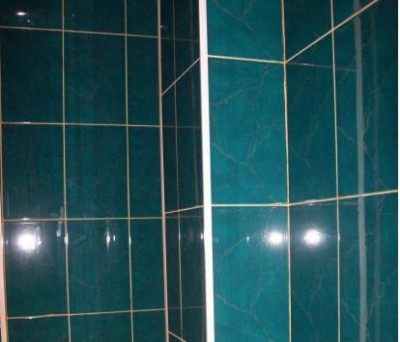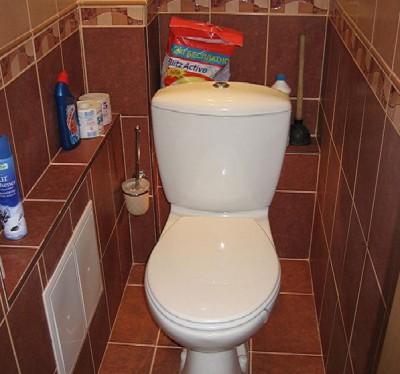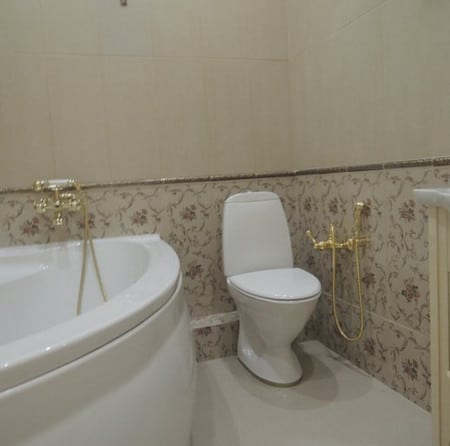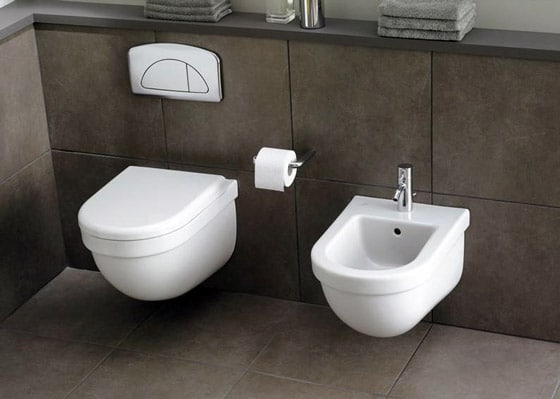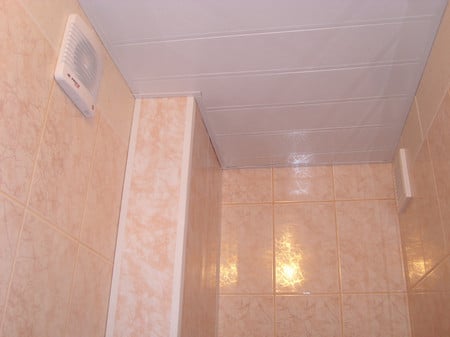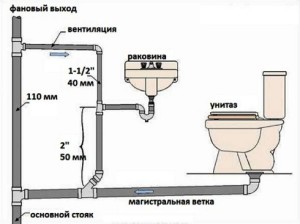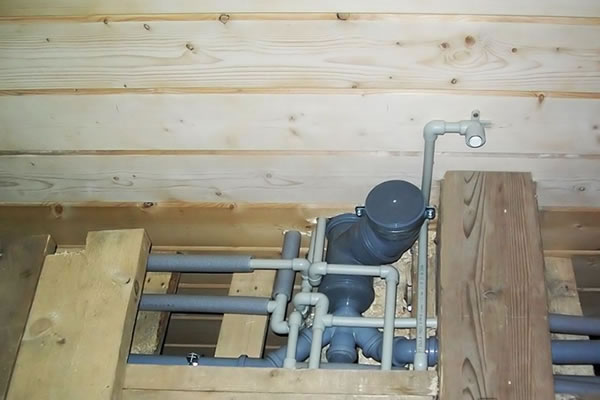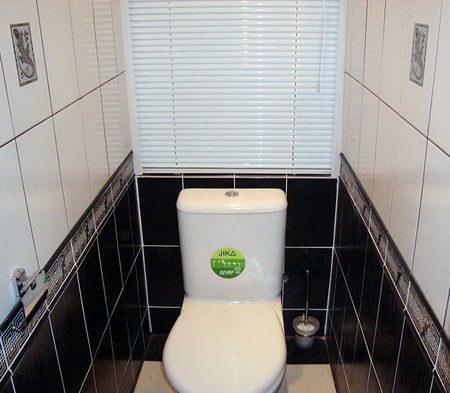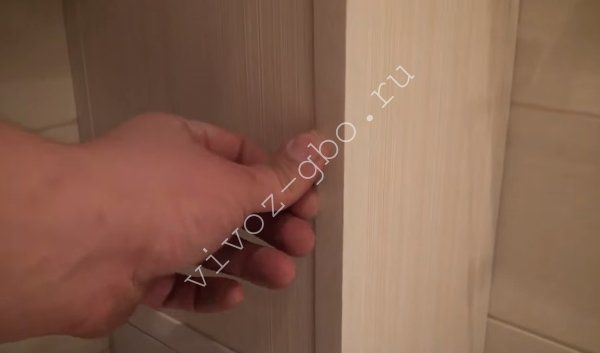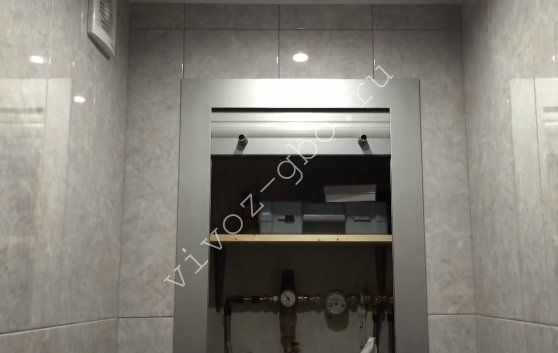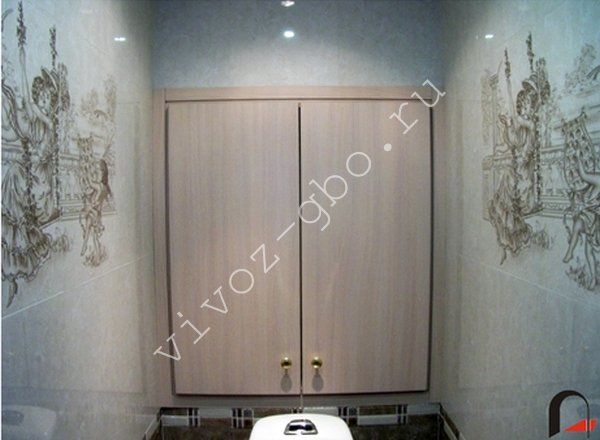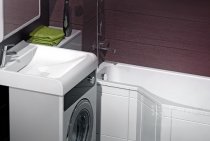How to close the sewer riser in the toilet ways
In an ordinary apartment with a separate bathroom, almost all pipes are located in the toilet. Here, as a rule, there are counters, taps are made. The already small toilet looks like a technical room. And the toilet was here quite by accident.
There are several ways to hide all this disgrace.
1. Construction of a false wall.
One of the simplest and most common options is to completely cover the riser in the toilet with drywall. It must be borne in mind that a false wall will take up about half a meter of free space. The toilet room is already small, and after sewing up the riser, not everyone will be able to sit freely on the toilet.
Exit - hanging toilet. A special frame on which the plumbing fixture is attached and the drain tank will be hidden behind drywall. This will save space.
A false wall can be not only attractive, but also functional. If you equip free space with shelves, then you can store household items there.
2. Construction of a square box.
This method is suitable if all pipes are in the same corner. The box saves free space. And with this option, you need to leave the door opposite the meters and valves.
3. Oblique false wall equipment.
It goes at an acute angle to the side or rear wall. It is advisable to refer to this method of masking the riser in the case when thinner pipes move away from the main pipe. The toilet will have to be slightly shifted to the side.
4. Creation of a multi-level box.
When pipes are "scattered along the walls" of the toilet room, it is better to build a multi-level structure. Each of its elements will cover a separate section of the network.
The box can be two-level, three-level. Building it, of course, is more difficult. But space is saved and stands for important little things are obtained.
How to get rid of a pipe once and for all
For those who are not looking for easy ways, prefer to do everything thoroughly, there is a cardinal way to get rid of the riser - transferring it to the wall. As a result, the area of the room does not decrease, the even and smooth wall fits perfectly into the interior conceived by the designers.
The walls will become smooth and nothing will disturb the harmony
This option is not possible in every house, but only where the thickness of the partitions allows you to cut out the strobes. The capital method will require a complete replacement of communications, including passages through floors, you will have to notify neighbors and incur additional costs.
Another way to remove unsightly details is to install overhead plumbing. This process requires a professional approach, not always the thickness of the walls will allow this.
Suspended plumbing not only conceals ugly pipes, but also adds lightness to the room.
A simple option for protection from plastic panels
Plastic is ideal for building a false wall, it is not afraid of moisture, temperature changes, mold. rot, easy to clean, quickly disassembled if necessary. A significant advantage of the panels is that they do not have to be putty and painted - it is enough to choose a shade and pattern to match the color of the tile.
The color of the panels is easy to match the shade of the tile
To fasten the panels, it is required to build the same frame as for a drywall screen. In this way, make a false wall, and a box. Overlaying ceramic tiles or applying textured plaster on a plastic coating will not work, for these cases you will have to choose drywall.
Actually work
Everything is checked, invented, materials are bought. Now the work itself.
1. Mounting the frame.
If an oriented strand board is used for sheathing, then the frame is made of wooden blocks.For drywall we use a metal profile. And how to close the riser in the toilet with plastic panels? Better on a wooden frame.
- Set up the vertical guides.
- We fasten the transverse jumpers to give rigidity. The step is determined by the dimensions of the skin material, as well as taking into account the dimensions of the inspection hatch.
2. Sheathing.
For deaf structures, drywall is more suitable. To create a removable skin, it is preferable to use oriented strand board. She is stronger. And dismantling will not harm her.
3. Finishing.
Tiles are attached to the skin with glue, plastic panels with brackets. You can just putty and paint.
If the highly visible communications located in the bathroom spoil the interior of the room, then this is not a problem. Figure out how to close the riser in the bathroom, and get to work.
In order not to have to mask numerous and long pipes, draw up a diagram of all communications in advance and try to arrange them and plumbing so that in the end all utilitarian details remain as inconspicuous and hidden from view as possible. But still, this is far from always possible, and often it is simply impossible to completely hide the riser. But such a problem is not as difficult as it seems, if you know the ways to solve it.
Sewage connection diagram
Sewer wiring
Even at the stage of designing a house, a drainage system should be developed that would harmoniously fit into its structure. Initially, the location of the common vertical riser is marked on the diagram. It is usually located in the bathroom or toilet. Horizontal drain pipes diverge from its lower part. It is to these pipes that all plumbing fixtures are connected through siphons.
The bathroom usually has a sink, bathtub and washing machine. The toilet is connected to the toilet and bidet (if available). The kitchen usually has one sink or shared with a dishwasher. The sewerage scheme in the house provides for the inclination of all horizontal pipes towards the riser by at least 3 degrees to ensure gravity flow of drain water.
Elements of the sewer system
Installation of internal sewerage is carried out using key elements, without which it is impossible to do.
The elements of house sewerage include plumbing fixtures, connecting pipes, fittings, splitters, siphons, elements of fastening the pipeline to the walls. Pipes are now used mainly polypropylene or metal-plastic. Steel pipes are already out of use. Exceptions are copper pipes or stainless steel products. However, their cost is very high. The connecting elements are made from the same material.
The risers are now also used plastic. However, if you do not change the main riser, which is made of cast iron, then you will need additional rubber adapters to connect the plastic pipes and the cast iron riser. The riser has a standard size of 100 mm. In some cases, when it comes to a multi-storey building above five floors, a riser with a diameter of 150 mm can be used.
The purpose of the riser is to compensate for water hammer in the system and the absence of odors in the house. If it is not possible to bring the riser up, outside the house, then a vacuum valve is installed at its outlet, which solves the same problems. The diameters of the drain horizontal pipes are usually 50 mm.
Laying sewer pipes in the house
We will prepare everything necessary for the installation of the sewer system.
Installed sewer pipes
The rules for installing sewer pipes provide for the use of the following tools for work:
- Scissors for cutting polypropylene pipes.
- Perforator.
- Hacksaw for cutting metal.
- Level.
First, all elements of the system are assembled together. That is, they are cut and fitted.It is better to cut pipes with special scissors, but you can also use a hacksaw.
Installation of sewer pipes in the house is carried out at the bottom of the wall, observing the necessary slope to the riser. After joining the pipes, the pipeline is fixed to the walls using a perforator and special round latches. The connecting fittings also have sockets with seals, so all connections are made easily.
In this way, literally in one day, you can completely mount the sewer system in your home. Now on sale there is everything necessary for these purposes.
The easiest roller shutter exit
The fastest way to solve the problem of hiding sewers is with the help of roller shutters. This design maximizes access to pipes, while there are no doors cluttering up the space. To hang blinds, no experience is needed, and beautiful curtains do not need any additional finishing.
Plumbing shutters are not only beautiful, but also practical
Considering the increased demand, manufacturers produce special plumbing shutters, endowing them with soundproofing and heat-saving properties. If desired, it is easy to choose a color that is in harmony with the decoration of the entire room.
Space saving conduit box
The wall completely covers the utility part of the room, but significantly reduces the usable area. In order to save space, as well as for sheathing protruding risers, build a conspiracy box by hiding the sewer pipe. Making a frame for the box will be a little more difficult, as you have to tinker with the corners. A strong corner is easy to obtain from two ud-profiles fastened together, directed by the shelves at right angles.
According to the arrangement of elements that need decoration, the protection system can be trihedral or tetrahedral. When there are many protruding parts below, and only a riser is located at the top, a multi-level box can be built. So there will be more space, an additional shelf for storing small things is formed.
Choose galvanized profiles for the frame. For a separate toilet, where the humidity is significantly less, it is allowed to use wooden bars.
Capital way plasterboard wall
The easiest way to hide the sewerage, passing in a technical niche, with the help of a false wall. Use plywood or chipboard as the material, but drywall is considered the best option. For work, one sheet of dry plaster will be enough, it must be green in color - this is what moisture-resistant drywall looks like, suitable for use in wet rooms.
A completely closed technical niche is difficult to see with the naked eye
The false wall frame is made of galvanized profiles (which is preferable) or wooden bars. When marking the attachment points of the profiles, it must be taken into account that the distance between the partition and the riser must be at least 3 cm. First, the guide profiles are attached to the walls, then to the floor.
If you plan to decorate the plasterboard screen with tiles, then it is necessary to provide a distance between the rack profiles of no more than 40 cm. In cases where there are already ceramic tiles on the walls, drilling should be done in the tile joints.
Drywall is cut according to pre-prepared drawings and attached to the frame using self-tapping screws. The finished wall is puttied and decorated according to their own wishes, the overall design. To simplify the work with the inspection door, make it less noticeable, use a simple but convenient magnetic mount.
Video how to close the riser
If your own experience for a quality repair is not enough, you can always seek qualified help from specialists. Professionals will quickly evaluate all possible options, make calculations and permanently hide the ugly sewer from their eyes in the most appropriate way.
Is it possible to close the sewer riser? Yes, you can, the main thing is to do it right. There are several ways to get this job done.
The use of a false wall. This is the most capital method. In order to make it, you will need plywood or chipboard
We also recommend that you pay attention to drywall. Before installing the ceiling, completely remove all rust and paint the structure.
Use galvanized profiles to complete the false wall frame. Fasten the profiles to the walls, then to the floor. There should be a distance of 3 cm between the partitions. The drywall is fixed to the frame with self-tapping screws. The sewer pipeline is hidden in the box. This design can be trihedral and tetrahedral. Sometimes multi-level boxes are mounted. This method is the best option if you close the riser in the bathroom. If you have a separate toilet, you can use wooden bars instead of galvanized profiles.
Plastic panels. This is a very practical material, which is not affected by external irritants such as humidity, temperature changes, mold. They are also easy to disassemble and assemble, no need to paint and putty. It is enough just to pick up plastic panels of the required color. You will need to build a frame for the wall and box, lay the panels.
Roller shutters. If you do not want to waste time on complicated ways, you can close the sewer pipes with roller shutters. They do not require finishing, they are easy to install, as they are ordinary blinds, and they provide maximum access to the riser. Now there are special designs, for example, with sound insulation and heat saving.
- Drywall or plastic box. Use a metal profile and just sheathe it with plastic.
- Household closet. This is a great option to disguise faucets, filters, meters and pipes and store cleaning products, household items. Make a frame from wooden bars, fix it with dowels to the walls of the toilet, install hinges and doors. For the manufacture of the locker, laminated chipboard and plywood are suitable.
Ways to mask the riser
So how can you close the riser in the bathroom? You can do this in a variety of ways:
- Wall disguise. In this way, you can hide the riser only at the stage of its installation. And the work is very difficult and time-consuming, be prepared for this. First you need to draw up and transfer to the wall the layout of all communications. Then, using a perforator, recesses should be made that slightly exceed the diameter of the pipes. Next, pipes are laid in the strobes. Then it is desirable to close the entire surface with plasterboard, chipboard, plywood or PVC panels to make a kind of false wall. It is not recommended to fill the recesses with concrete; in case of breakdowns and dismantling, you can severely damage the riser.
- Closet. Yes, you can hide the riser in the closet. Moreover, you can both purchase a finished piece of furniture with a missing back wall and slots in the shelves, or make it yourself from the usual one. You will need to dismantle the back. Then, using a crown and a drill, make holes in the shelves of the diameter corresponding to the pipes. This method will not only hide the riser, but also provide additional space for storing products or hygiene items.
- The box is the most common way to mask communications. It is convenient in that you can purchase a finished design of the desired size in a plumbing store. It is easy to install, so its installation will not be difficult. In addition, there are different options for shapes and configurations: triangular, rounded, rectangular boxes, as well as those consisting of one or more levels.
- Plasterboard partition. To mount it, you must first install a solid frame, which is usually made of galvanized profiles.Although some use wooden beams, this material requires additional treatment with moisture-proof and antifungal agents. Further, the plasterboard sheets themselves are attached to the frame with the help of self-tapping screws, and it is advisable to use moisture resistant ones, since the humidity in the bathroom is significantly increased. The next step is finishing. You can use different materials, but PVC panels and ceramic tiles will be the most practical and preferred.
- Plastic panel construction. Plastic panels are practical, inexpensive, moisture resistant, lightweight and relatively easy to install, as they have convenient joints. But the only drawback of using them is the complete lack of sound insulation, any sounds will penetrate through them. If that doesn't bother you, then get to work. First, install the frame, which can be made in the same way as for a plasterboard partition. But in this case, it is desirable to use a metal profile. Install plastic panels on it. The joints can be masked with corners.
- Roller shutters will allow not only to hide all communications from the eyes, but also to leave unhindered access to them. At any time, you can move the shutter to, for example, open or close a valve or troubleshoot problems. Rolleta are established in guides. At the same time, the riser itself should be located in a recess so that it does not interfere with the movement of the shutter. And along the edges of such a recess, the frame of the future structure is just mounted. Currently, you can purchase special roller shutters designed for bathrooms and toilets. They not only play the role of camouflage, but also perform hydro and noise insulation functions, as they are equipped with an additional internal coating.
